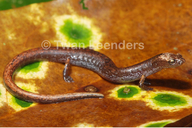|
Oedipina alleni Taylor, 1954
Subgenus: Oedopinola | family: Plethodontidae subfamily: Hemidactyliinae genus: Oedipina |
 © 2007 Twan Leenders (1 of 12) |
|
|
|
Description Diagnosis: Oedipina alleni can be distinguished from other species in its genus by the following combination of characters: moderate size, light brown coloration usually with extensive light markings on the head and tail, 17 costal grooves, snout long and bluntly pointed, and digits with distal portions free of webbing (Savage 2002). Description: A moderate-sized salamander, with adults measuring 114 - 151 mm in total length. The standard length of males ranges from 40 - 48 mm and that of females is between 42 - 58 mm. Oedipina alleni is a somewhat uncommon moderate-sized light brown salamander with long limbs. This species has 17 costal grooves, and 6.5 - 8.5 costal grooves are present between adpressed limbs. Head width is 8.5 - 10.6% of standard length. The snout is long and comes to a blunt point. Eyes are small. Its fingers and toes have distal portions free of web. The tail is robust and moderately short (56 - 62% of the total length). Up to four maxillary teeth are present but do not extend posteriorly beyond the choanae. Vomerine teeth number 11 - 19. Legs are long, 17 - 22% of standard length. Hands and feet are neither flat or broadly palmate. Toe III is bluntly rounded. Distal portions of the digits are free of webbing. The dorsal surfaces of Oedipina alleni are light brown with cream-colored markings on the tail, head, and body. These markings include an occipital light blotch. The venter is reticulated with brown around the cream spots (Savage 2002). Similar species: Oedipina alleni can be distinguished from O. savagei by having a narrower head (broader for O. savagei), a bluntly pointed snout (vs. broadly rounded snout for O. savagei) and by having fewer maxillary teeth (0 - 4 not extending posteriorly beyond choanae, vs. 7 - 18 maxillary teeth that continue posterior to the level of the choanae for O. savagei). O. alleni can be distinguished from O. collaris by having a bluntly pointed snout (vs. truncate for O. collaris) and by having fewer costal grooves (17 for O. alleni, vs. 19 - 22 for O. collaris) (Savage 2002).
Distribution and Habitat Country distribution from AmphibiaWeb's database: Costa Rica
Life History, Abundance, Activity, and Special Behaviors Trends and Threats Possible reasons for amphibian decline General habitat alteration and loss Comments A Spanish-language species account can be found at the website of Instituto Nacional de Biodiversidad (INBio). Species authority: Taylor (1954). Brame (1968) synonymized O. alleni with O. parvipes; subsequently Good and Wake (1997) resurrected the name O. alleni for the Costa Rican and western Panamanian forms, which were found to comprise a distinct taxon from the forms in central Panama to western Colombia.
References
Bolaños, F., Chaves, G., Ibáñez, R., Solís, F., Wake, D., and Savage, J. (2008). Oedipina alleni. In: IUCN 2010. IUCN Red List of Threatened Species. Version 2010.3. www.iucnredlist.org. Downloaded on 19 October 2010. Brame, A. H., Jr. (1968). "Systematics and evolution of the Mesoamerican salamander genus Oedipina." Journal of Herpetology, 2, 1-64. [link] Good, D. A., and Wake, D. B. (1997). ''Phylogenetic and taxonomic implications of protein variation in the Mesoamerican salamander genus Oedipina (Caudata: Plethodontidae).'' Revista de Biología Tropical, 45(3), 1185-1208. Laurencio, D., and Malone, J. H. (2009). ''The amphibians and reptiles of Parque Nacional Carara, a transitional herpetofaunal assemblage in Costa Rica.'' Herpetological Conservation and Biology, 4(1), 120-131. Savage, J. M. (2002). The Amphibians and Reptiles of Costa Rica:a herpetofauna between two continents, between two seas. University of Chicago Press, Chicago, Illinois, USA and London. Taylor, E. H. (1954). ''Additions to the known herpetofauna of Costa Rica with comments on other species, no. 2.'' University of Kansas Scientific Bulletin, 36(8), 589-596. Wake D. B. (2020). ''A surprising fossil vertebrate.'' Science, 370, 654-655. [link] Originally submitted by: Aisha Butt (first posted 2009-11-04) Edited by: Kellie Whittaker, Michelle Koo (2020-12-07) Species Account Citation: AmphibiaWeb 2020 Oedipina alleni <https://amphibiaweb.org/species/5349> University of California, Berkeley, CA, USA. Accessed May 24, 2025.
Feedback or comments about this page.
Citation: AmphibiaWeb. 2025. <https://amphibiaweb.org> University of California, Berkeley, CA, USA. Accessed 24 May 2025. AmphibiaWeb's policy on data use. |



 Raffaëlli Account
Raffaëlli Account Map of Life
Map of Life